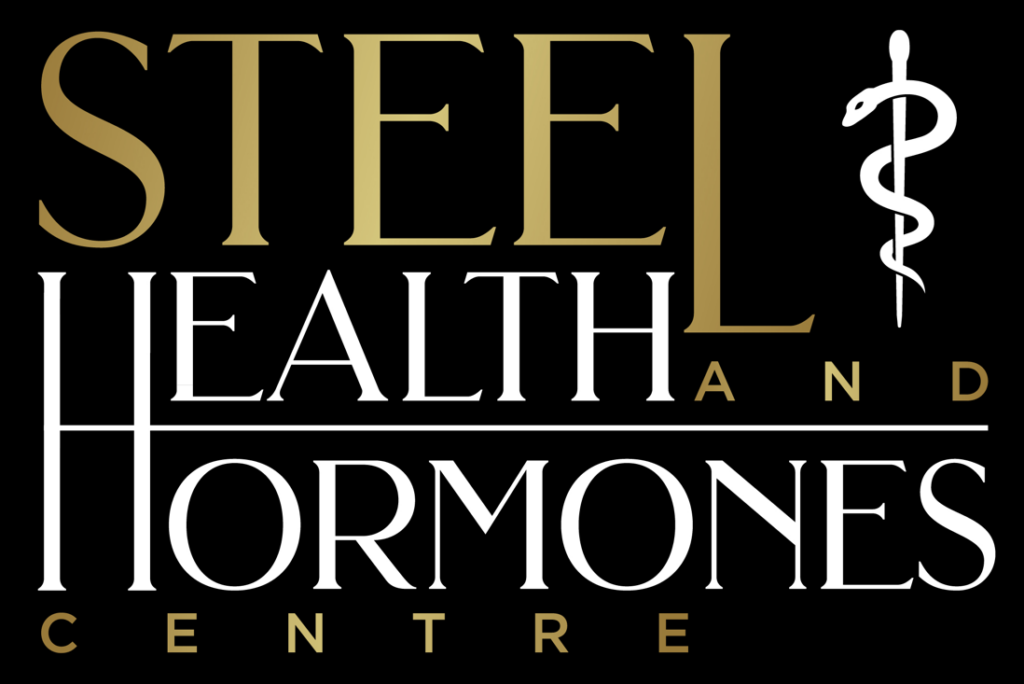Female hormone replacement therapy (HRT) is quickly becoming the leading form of therapy we offer at Steel Health and Hormones Centre. We deploy bioidentical estradiol, progesterone, and testosterone therapy in women experiencing hormonal dysfunction, perimenopausal, and postmenopausal women. Today, I will take a deep dive into the primary methods of administration for estradiol therapy. We’ll briefly discuss the benefits of estradiol therapy as well
as the most common methods of administration: oral, transdermal, and injection. If you’re a woman interested in getting the maximal benefits of estradiol therapy while minimizing potential side effects, this article is for you.
A few key points to understand about this topic before we dive in. First, I’ve already thoroughly refuted the Women’s Health Initiative (WHI) study in a previous blog post. I encourage women who are considering HRT but are worried about the conclusions reached by the WHI to read that previous blog post. In short, I conclude that the WHI is not a good representation of modern female HRT run at a reputable clinic like Steel Health and Hormones Centre, located east of Pittsburgh, PA. We use different medications than those used in the WHI, and therefore we believe that our methods are considerably safer and may offer additional benefits when compared to medications and methods used in the WHI. In fact, a recent systematic review in Gynecological Endocrinology shows a trend towards the safety and benefits of bioidentical oral estradiol vs. FDA-approved conjugated equine estrogen. The limitation of the systematic review is that the studies observed were often observational, which is not the gold standard of research.
I also want to preface this blog post by stating that I am not a doctor. While I am the owner of Steel Health and Hormones Centre and this article is well-researched, it is not to take the place of the care of your doctor. This article is not meant to diagnose, treat, or prevent disease. This article is also not meant to alter your therapy already assigned to you by your doctor. This article is for informational purposes only. If you’re interested in any medical advice or therapy, it should be done under the strict care of a doctor. If you don’t have a doctor knowledgeable in HRT, then please fill out a contact form at the bottom of the page and we would be happy to help you.
The final preface of this article has to do with the administration of estradiol therapy as one part of hormone replacement therapy. Estradiol is rarely prescribed alone, and never prescribed alone for women with an intact uterus. The difficulty of this article is to observe estradiol therapy with a consistent administration of bioidentical micronized progesterone. I’m going to do my best effort to include studies and methodologies comparing methods of estradiol administration without confounding factors like the inclusion or exclusion of micronized progesterone. Admittedly, this is difficult and leaves me wanting better studies, including head-to-head studies observing methods of administration of estradiol with micronized progesterone held consistent. However, this is the best synthesis of data that I could aggregate. This tested my formal training in mathematics and statistics, and I believe I presented the fairest case I could given the data currently available.
Now let’s get into this…
Estradiol is the primary estrogen in the female body. It is primarily produced by the ovaries and offers a myriad of benefits. Adequate estradiol allows for bone health, cognitive protection, skin health, and quality of life. Many women deal with estradiol dysfunction, with the most notable
dysfunction coming during perimenopause and menopause. The most obvious symptoms of changes in estradiol include vasomotor conditions such as hot flashes. Other obvious symptoms some women discuss include vaginal dryness, moodiness, and loss of libido.
Administration Method 1 – Oral Routes
A common method of administration for estradiol therapy is a compounded capsule of micronized estradiol of various strengths. The ease of taking a pill compared with the “messiness” that comes with creams or the slight pain that comes with injections is an appealing method of administration for many women seeking HRT. The two ways estradiol can be taken orally are in a capsule or a troche. A capsule is swallowed, while a troche is dissolved under the tongue. Let’s break these administration methods up into their own parts.
Capsules
Capsules have been shown to raise estradiol in a dose-dependent manner. The more you take, the higher your serum levels will rise. What’s proprietary about the capsule route is that the oral estradiol is subject to “first-pass” metabolism by the liver. The clinical impact of liver metabolism is up for debate. Detractors of oral capsule estradiol delivery explain that it causes an increase in localized estrogens in the liver that is magnitudes higher than in the serum. This has been shown to increase certain clotting proteins. However, it’s important to understand that just because something increases the prevalence of a clotting protein, doesn’t necessarily result in a clinical increase in clotting. A French study showed that oral routes did increase clotting when compared to a transdermal route. The study also showed that clotting was dramatically increased in women with Factor V Leiden. However, I cannot get the raw data on this study to see if the medications they used were oral estradiol or CEE, which, as stated above, makes a tremendous difference in clinical outcomes.
Those who believe in capsule oral estradiol therapy explain that oral estradiol also increases estrone, which is metabolically weaker than estradiol but can be converted into estradiol. Therefore, oral estradiol acts as both a hormone and a prohormone for the hormone we’re trying to increase. Believers also explain that pills can be an easier delivery method for some patients.
Clinically, I believe this is where individualized medicine comes into play. For women with Factor V or a family history of blood clots, I would encourage them to avoid micronized estradiol in capsule format. Women who have additional risk factors for clotting may also want to consider a different method of administration. I don’t believe the research is robust enough to blanketly state that capsule oral estradiol should be contraindicated in all women, but out of an abundance of caution, I can see where other delivery methods may be the safer option.
Troche
The second route of oral estradiol is in troche form. Troches are dissolved in the mouth and absorbed through the thin skin lining the mouth. Most people dissolve a troche under the tongue. The idea behind a troche is that it enters the bloodstream directly without suffering from the drawbacks of a capsule (first-pass of the liver). This is a convenient alternative for women who may suffer from an increased risk of clotting, do not like injections, and are irritated by a transdermal cream.
On paper, troches seem to have all the benefits of a capsule, with none of the potential drawbacks surrounding oral estradiol’s first-pass of the liver. However, in practice, I don’t believe this is entirely true. I believe that some of the medication will be ingested and will be subject to the first pass of the liver. The human body naturally salivates when something is in the mouth, and some of that saliva will be ingested. It’s reasonable to conclude that some of the medication will be ingested with the increased saliva production. Therefore, high-risk women may choose a different method of administration.
Administration Method 2 – Transdermal
The next method of administration is transdermal administration. This can come in the form of a bioidentical estradiol patch or transdermal cream. Transdermal administration completely bypasses the first-pass of the liver, potentially lowering the risk factors that may be associated with oral administration. When a woman is at high risk for clotting, this method of administration is almost always the safest route.
The drawbacks to transdermal cream are two-fold. The first issue of transdermal estradiol application comes with absorption. The thickness of our dermis is genetically determined, and some women find it hard to achieve therapeutic levels of estradiol through transdermal administration. Other women may find their dermis is much more porous and even the smallest dose results in large spikes of estradiol. The second issue of transdermal estradiol administration is convenience. Some women find the cream to be messy and a skin irritant. Other women, due to their lifestyle, find that the patch simply will not stay on their skin long enough to achieve therapeutic levels of estradiol.
A potential issue with transdermal administration has to do with the metabolic activity of the dermis. There is evidence to suggest that enzymes in the skin may break down certain compounds and result in metabolic byproducts of said compound. The evidence is clear that transdermal administration results in much fewer metabolic byproducts compared to oral estradiol. I cannot find literature comparing the difference between transdermal and injectable estradiol in terms of metabolic byproducts; however, the absence of evidence is not evidence of absence. My conjecture is that the difference is minimal and insignificant, but without further data, it’s impossible to know.
With all of that taken into account, we find that transdermal estradiol administration is our preferred method of estradiol therapy. We find that most women are able to achieve therapeutic levels of serum estradiol through either a patch or cream rubbed on the upper arm or inner thigh. We find this method to be the safest, well-tolerated, and efficacious method of administration.
Administration Method 3 – Injection
The final common method of estradiol administration is through injection. Like transdermal administration, injections bypass the first pass of the liver and may potentially lower the clot risk. Unlike transdermal administration, there is no messy cream or patch to manage. Estradiol injections allow us to know exactly how much estradiol is being administered and there is no chance of dermal enzymes breaking down estradiol into its biochemical metabolites.
The issues with injectable estradiol are two-fold. The first has to do with convenience. Some women find the idea of an injection to be unsettling and would prefer a capsule or cream. Further, disposing of sharps adds another layer of inconvenience other methods of administration do not confer. A quick understanding of pharmacokinetics is required to understand the second issue with injectable estradiol.
Injectable estradiol is attached to what’s called an “ester.” The ester slows down the absorption of the medication to allow for a more stable serum concentration. If we look at the most available form of injectable estradiol, it’s attached to an Enanthate ester. The half-life of that ester is 8 days. This means after 8 days, half of the targeted medication (in our case, estradiol) is present in the serum. However, this does not mean that it rises and falls at the same rate; rather, the medication “spikes” and then slowly falls over time. It takes 5-6 half-lives for a medication to be undetectable in the serum.
This brief understanding of pharmacokinetics should show some of the issues with injections. First, we want to stabilize serum levels of estradiol, not spike them quickly and have them fall over time. We can fix this by more frequent injections, but then that brings us back to issue number one: convenience. The half-life of the medication also presents a problem. If the client has issues with estradiol therapy, it will take some time for the medication to completely leave the system. Transdermal estradiol has a significantly shorter terminal half-life when compared to injectable, which allows for faster clearance and easier dose adjustments.
We do not often use injectable estradiol for the above reasons. We prefer transdermal cream. However, for patients who simply cannot absorb transdermal medication and present significant clotting risk factors, injectable estradiol is on the table.
In Summary:
- The three most common delivery methods of estradiol therapy are oral, transdermal, and injectable.
- Oral estradiol should be contraindicated in women with risk factors associated with clotting, or women who are unsure of their Factor-V Leiden status.
- Transdermal estradiol therapy is our preferred method of estradiol administration because it is safe, efficacious, and easy to adjust.
- Injectable estradiol may have its place in female HRT but presents issues surrounding convenience and medication clearance.
If you’re in the Murrysville, Delmont, Greensburg, or Latrobe area and you’re interested in a white-glove approach to hormone replacement therapy, please fill out a contact form down below and someone will be in touch within 24 hours.
Sources



